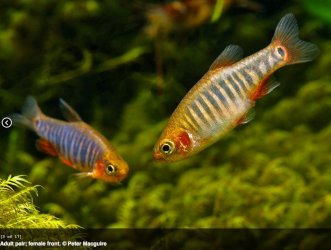Byron said:
I would definitely not add any pure ammonia. Ammonia is toxic to all life forms, including plants, and it is possible to kill off these plants with too much ammonia. Once you have live plants in the tank, I would not add ammonia.
Quite interesting you take this sort of stance. Of course this varies between fishkeepers and their preferences which is no bad thing at all.
I have always cycled a tank with live plants AND using ammonia with no ill effects on the plants as far as I could see. I usually set up the tank with plants and substrate etc, leave for 2 weeks to let plants settle, then start the cycling process by testing and adding ammonia to the required amount.
The problem for me is the risk. This is another area where it is so easy to overdose ammonia, which can kill plants, bacteria...not worth it really. Aside from this, high ammonia does affect the second stage of nitrification, and at not very hgih levels can inhibit and even kill the Nitrospira bacteria. When the live plants method is so easy and safe, I tend to think it the better option.
Live plants are faster at taking up ammonia/ammonium than bacteria, according to test studies. So once you have established the nitrifying bacteria, it is not going to have "food" once the ammonia stops. Some would argue that it will compete with the plants, and there is test evidence this occurs. Which is why biological filtration is unnecessary in planted tanks. Obviously nitrifying bacteria will appear and be present, regardless. I see no value in trying to over-encourage this at the risk to plants and bacteria.
Your stance is a hard line here, Byron. I respect that this is your opinion, but do not agree with the degree to which you take it. The term "planted" tank is where this needs some degree of leniency. First, how planted does a planted tank have to be in order for this to be used most effectively? The general recommendation that I've seen for a silent cycle as you are describing here has always been up to as high as 75% of the substrate be planted and normally with fast growing plants. (Granted floating plants are also useful in this regard.) And generally, speaking I've never heard of a new hobbyists planting their new tank to anything even close to that regard. Second, the priority, as you yourself claim, should be the fish and other animals in the tank.
If a new hobbyist considers their tank to be planted because they bought a pair of tiny anubias plants and put fish in right away, they would be asking for trouble. That amount of plant matter just won't be able to keep up with the bio load and the ammonia will build up becoming a danger to both the fish and the plants.
I do agree that caution be used when adding ammonia to a tank with plants in it during a cycle. The dose should smaller than the 3 ppm we recommend in our cycling article. The dose I use would be around 1 ppm. This is generally a small enough dose to be safe for all but the most sensitive plants, and those plants are generally not the ones being used by newer hobbyists. This gives the hobbyists a chance to see how much ammonia is being consumed by the plants, if tested after a day. If the ammonia is gone, then they can safely proceed with a small stocking of fish. If not, then they wait until that amount of ammonia can be processed in a day before proceeding with.
The possibility of overdose is always possible, as it would be with medication, etc. So, having a bit of practice calculating their dose for 1 ppm and measuring out some ammonia for this purpose is valuable experience as well. And IF they overdose the ammonia, the only thing lost (potentially) are some plants. These can easily be replaced at a cost of a few dollars, pounds, etc.


 ) and should be perfectly safe I reckon.
) and should be perfectly safe I reckon.


